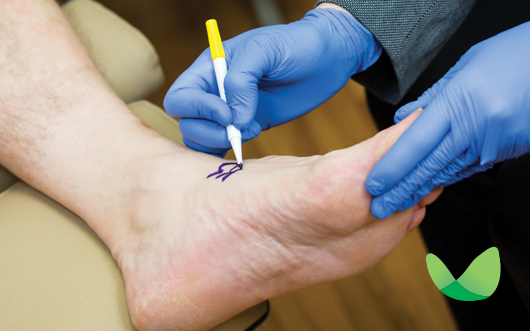HAMMERING AWAY HAMMERTOES with DR. JAMES RENIER

As a board-certified podiatrist, Dr. James Renier’s goal is to keep people on their feet and maintain a healthy lifestyle!
With his undergraduate degree from St. John’s University in one hand, and a signed contract to work at Abbott Northwestern in the other, Dr. James Renier was well on his way to becoming a highly sought-after Cardiothoracic Surgeon. Yet, after working closely with some of the best cardio docs in the country With his undergraduate degree from St. John’s University in one hand, and a signed contract to work at Abbott Northwestern in the other, Dr. James Renier was well on his way to becoming a highly sought-after Cardiothoracic Surgeon. During his training, he was introduced to podiatry and realized he had a passion for helping people maintain a healthy lifestyle and keeping them on their feet. Years later, Dr. Reiner is a board-certified podiatrist at St. Cloud Surgical Center and enjoys the work/life balance the specialty of podiatry allows.
As we learned before, the inner workings of your foot and ankle are very complex. Each foot is comprised of 26 bones, 33 joints, and more than 100 muscles, tendons, and ligaments that provide support, balance, and mobility. For the mechanism to work correctly, all of these pieces must work seamlessly together; even the slightest disruption to the foot mechanism can cause extreme pain. Perhaps, the most common disruption we see is when the forces of the tendon on the top and bottom of the toe don’t line up, causing a hammertoe.
While the name “hammertoe” can seem alarming, these are quite common and a large part of what
Dr. Renier and the rest of the foot and ankle team at St. Cloud Surgical Center treat nearly daily. According to Dr. Renier, roughly 15 out of 20 patients per day see him for some component of hammertoes and foot deformity. Primarily, the cause for hammertoes has to do with the patient’s biomechanics and is not always avoidable as we age. For example, a low or a high arched foot can be more susceptible to hammertoes because the tendons cause an imbalance that causes their toes to bend in a very uncomfortable way.
If you are struggling with a hammertoe, there is hope for correction. Dr. Renier firmly believes that less is more and assesses every situation on a case-by-case basis. In most cases, he prefers to weigh conservative options before jumping to surgery. These options could include the following:
- Orthotics, wider shoe wear modifications
- Corn & Calluses Shields, silicone, fabric, etc.
- In-office procedures like Flexor Tenotomies
- Some Physical Therapies
However, sometimes conservative methods will not alleviate the pain from hammertoes, and surgery is necessary. You may be a strong candidate for surgery if you’re experiencing one or more of the following symptoms that have gone uncorrected following conservative measures:
- An abnormal bend in the joints of your toe
- Corns or calluses
- Bone pain, Metatarsalgia
- Tears in the joint capsules due to force
- Additional foot deformities are present
If you need surgery for a hammertoe or another foot deformity, you can expect to experience some downtime after surgery. For the first 3 to 5 days post-op, patients are required to be non-weight bearing. Since procedures at St. Cloud Surgical Center are all outpatient, you’ll want to ensure you have someone by your side to help you with your day-to-day routine! After that short time, patients will switch to a medical walking boot for the rest of their recovery. Dr. Renier says most of his patients are back up and running in about 6 weeks.
While the recovery time is not short, the result of straighter toes, walking without pain, and returning to your favorite footwear is undoubtedly a win for patients!
For more information on Dr. James Renier and his current practice, visit St. Cloud Foot and Ankle